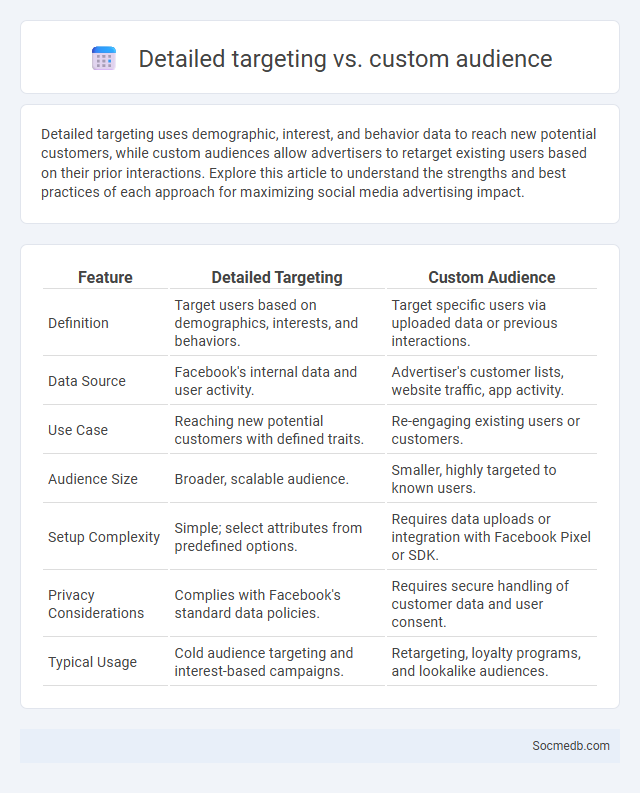
Photo illustration: Detailed Targeting vs Custom Audience
Detailed targeting uses demographic, interest, and behavior data to reach new potential customers, while custom audiences allow advertisers to retarget existing users based on their prior interactions. Explore this article to understand the strengths and best practices of each approach for maximizing social media advertising impact.
Table of Comparison
| Feature | Detailed Targeting | Custom Audience |
|---|---|---|
| Definition | Target users based on demographics, interests, and behaviors. | Target specific users via uploaded data or previous interactions. |
| Data Source | Facebook's internal data and user activity. | Advertiser's customer lists, website traffic, app activity. |
| Use Case | Reaching new potential customers with defined traits. | Re-engaging existing users or customers. |
| Audience Size | Broader, scalable audience. | Smaller, highly targeted to known users. |
| Setup Complexity | Simple; select attributes from predefined options. | Requires data uploads or integration with Facebook Pixel or SDK. |
| Privacy Considerations | Complies with Facebook's standard data policies. | Requires secure handling of customer data and user consent. |
| Typical Usage | Cold audience targeting and interest-based campaigns. | Retargeting, loyalty programs, and lookalike audiences. |
Introduction to Facebook Audiences
Facebook Audiences allow advertisers to target specific groups based on demographics, interests, and behaviors, enhancing ad relevance and performance. Custom Audiences enable reaching existing customers by uploading contact lists or tracking website visitors through the Facebook Pixel. Lookalike Audiences help expand reach by finding new users similar to a business's best existing customers, optimizing ad spend and engagement.
Defining Detailed Targeting
Detailed targeting in social media advertising enables precise audience segmentation based on demographics, interests, behaviors, and location, enhancing campaign effectiveness. Platforms like Facebook and Instagram offer robust tools to refine your target market, ensuring your ads reach users most likely to engage or convert. Utilizing detailed targeting allows you to optimize ad spend by focusing on relevant audiences, increasing ROI and engagement rates.
What is a Custom Audience?
A Custom Audience is a targeted group of users created by businesses using customer data such as email addresses, phone numbers, or website activity to deliver personalized advertisements on social media platforms. This audience helps advertisers reach existing customers or high-value prospects with relevant content, increasing conversion rates and return on ad spend. Platforms like Facebook and Instagram provide tools to upload and match customer data securely, ensuring precise targeting and improved campaign performance.
Understanding Target Audience
Understanding the target audience on social media involves analyzing demographics, interests, and online behaviors to create highly tailored content that resonates. Leveraging tools such as Facebook Insights, Instagram Analytics, and Twitter Analytics provides valuable data on user engagement and preferences. Accurate audience segmentation enhances campaign effectiveness by delivering personalized messaging that boosts conversion rates and brand loyalty.
Key Differences: Detailed Targeting, Custom Audience, and Target Audience
Detailed targeting in social media advertising allows advertisers to refine their reach by selecting specific demographics, interests, and behaviors, ensuring highly personalized campaigns. Custom Audience enables businesses to upload existing customer data, such as email lists or website visitors, to retarget or create lookalike audiences, enhancing conversion potential. Target Audience refers to the broader group defined by general characteristics that marketers aim to reach, serving as the foundation for applying detailed targeting and custom audience strategies.
Use Cases for Each Audience Type
Businesses leverage social media for targeted advertising campaigns, customer engagement, and brand building to increase sales and loyalty. Influencers use platforms like Instagram and TikTok to grow their personal brands, collaborate with sponsors, and create content that resonates with their followers. Your social media strategy should align with your audience type, whether it's consumers, professionals, or niche communities, to maximize impact and reach.
Pros and Cons of Detailed Targeting
Detailed targeting on social media allows advertisers to reach specific audiences based on demographics, interests, and behaviors, increasing the effectiveness of campaigns by delivering relevant content to potential customers. However, this precision can lead to privacy concerns and potential exclusion of diverse audience segments, limiting reach and potentially creating echo chambers. Your marketing strategy should weigh the benefits of refined audience targeting against the risks of reduced audience diversity and privacy issues.
Advantages and Limitations of Custom Audiences
Custom Audiences on social media enable precise targeting by leveraging data such as email lists, website visitors, or app users, enhancing ad relevance and boosting conversion rates. This targeting strategy improves ROI by allowing businesses to reconnect with existing customers and create personalized marketing campaigns. However, limitations include strict privacy regulations, potential data mismatches, and dependence on user consent, which can restrict audience size and targeting accuracy.
Best Practices for Audience Selection
Identify your target audience by analyzing demographic data, interests, and online behavior to ensure your content reaches the most relevant users. Tailor your messages and visuals to resonate with specific segments, enhancing engagement and conversion rates. You should continuously monitor audience feedback and platform analytics to refine your selection criteria and maximize campaign effectiveness.
How to Choose the Right Audience Strategy
Selecting the right audience strategy on social media requires analyzing demographic data, user behavior, and platform-specific trends to target the most relevant users effectively. Leveraging advanced targeting tools like Facebook Audience Insights and Instagram Analytics enhances precision by identifying high-engagement segments and optimizing ad spend. Continuous monitoring and adjusting audience parameters based on real-time performance metrics ensure sustained growth and improved return on investment (ROI).
 socmedb.com
socmedb.com